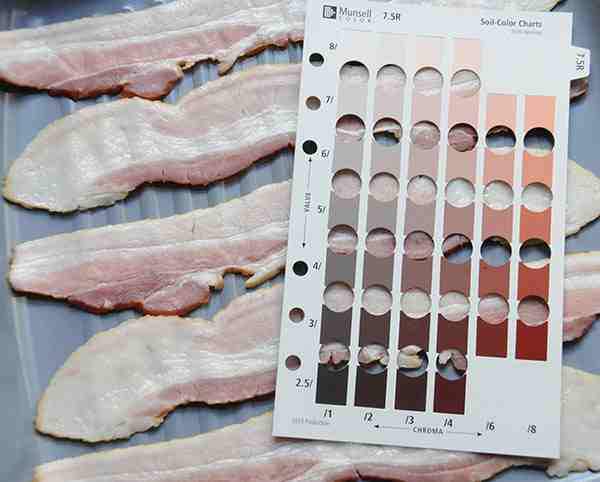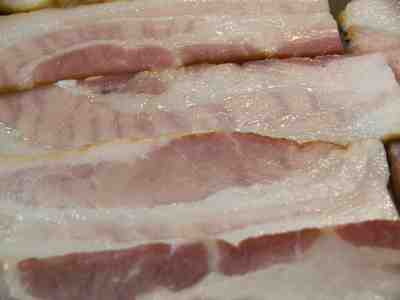The Required Legal Disclaimer of Bacon Even if your bacon matches the perfect Munsell color code, remember it must be at the correct temperature, 145 degrees for pork with a 3 minute rest (yes, it’s a long wait for bacon, but it’s worth it), to be considered safe for consumption.
What happens if you eat slightly undercooked bacon?

Eating uncooked bacon can expose you to both bacteria and parasites and can cause bacterial infections or trichinellosis, also called trichinosis, a parasitic infection. Read also : Can you eat bacon medium rare?. Bacterial infections and trichinellosis can both cause gastrointestinal symptoms.
Is it okay to eat slightly undercooked bacon? Is it safe to eat? Consuming undercooked or raw meat of any kind increases the risk of foodborne illness, known as food poisoning. That’s because this meat can contain harmful viruses, bacteria and parasites (1).
How long after eating undercooked bacon Will I get sick?
These symptoms can last for 5 to 45 days, but they usually start to appear 10 to 14 days after eating the contaminated meat. Milder cases of trichinosis are often mistaken for the flu or other common illnesses. Read also : Can you eat bacon raw?. In extreme cases, trichinosis can lead to death.
How long does it take to get sick from eating undercooked pork?
Signs of infection usually begin with an upset stomach within 1 to 2 days of eating contaminated, uncooked, or undercooked meat. Other symptoms can take 2 to 8 weeks to appear. Some people have only mild symptoms, while others become very sick. Serious infections can be life-threatening.
How do I know if bacon is undercooked?
As it cooks, the meat will begin to darken until it turns a reddish-brown color. When the bacon starts to turn from pink to brown, it’s time to test it to determine if it has reached the desired texture. On the same subject : What should I do if my child eats raw bacon?. If it gets too dark, it will taste bitter.
Does bacon have to be crispy?
So as we saw, bacon doesn’t have to be crispy to be “done.” Many people prefer bacon to be crispy, but a thicker slice of chewing bacon is my personal ‘ideal bacon!’ To be fully cooked, bacon must be cooked to an internal temperature of 145 degrees Fahrenheit.
What Colour should bacon be when cooked?
Bacon is considered fully cooked when the flesh turns from pink to brown and the fat has had a chance to set. It’s fine to remove the slices from the heat when they’re still a little chewy, but bacon is usually served crispy.
Does trichinosis go away?

Trichinosis is usually not serious and often gets better on its own, usually within a few months. However, fatigue, mild pain, weakness and diarrhea can last for months or years. Your doctor may prescribe medications depending on your symptoms and the severity of the infection. Antiparasitic medication.
How do you get rid of trichinosis? Trichinosis does not always require treatment. The infection may clear up without treatment within months of the onset of symptoms. However, the condition is often treated with medications to manage symptoms and prevent complications.
How do you know if you have trichinosis?
These symptoms usually include diarrhea (loose stools/poop), nausea (feeling sick in the stomach), tiredness and stomach pain. Other symptoms may appear 2-8 weeks after infection and may include fever, headache, chills, muscle aches, pain, and swelling around the eyes.
What is the incubation period for trichinosis?
The usual incubation period of trichinellosis is 8-15 days. After intestinal incubation, the first symptoms are usually gastrointestinal due to the invasion of the intestinal wall by the juvenile larvae.
How do you test for trichinosis?
To confirm the diagnosis, your doctor may use these tests: Blood tests. Your doctor may take a blood sample and test it for signs of trichinosis – an increase in the number of a certain type of white blood cell (eosinophils) or the formation of antibodies to the parasite after a few weeks.
What can happen if you don’t get treated for trichinosis?
Except in severe cases, complications related to trichinosis are rare. In cases of heavy infestation, larvae can migrate to vital organs, causing potentially dangerous, even fatal, complications, including: Myocarditis – an inflammation of the myocardium, the thick muscular layer of your heart wall.
What does trichinosis do to your body?
Headache, fever, chills, cough, swelling of the face and eyes, aching joints and muscle aches, itchy skin, diarrhea or constipation may follow the first symptoms. If the infection is severe, patients may have difficulty coordinating movements and have heart and breathing problems.
What are the long term effects trichinosis?
If left untreated, the parasites will die and calcify within 2-5 years. The long-term effects of trichinellosis include persistent or chronic muscle pain and decreased muscle strength.
Is trichinosis curable in humans?
Trichinosis is treated with antiparasitic drugs and can be fatal if severe cases are left untreated. There is no treatment once the larvae are embedded in the muscles, painkillers can help.
Is trichinosis fatal to humans?
Trichinosis can be fatal, depending on the severity of the infection; death can occur 4-6 weeks after infection and is usually caused by myocarditis, encephalitis, or pneumonia.
How long after eating undercooked bacon Will I get sick?

How soon after infection will the symptoms appear? Abdominal complaints can occur 1 to 2 days after infection. Further symptoms usually begin 2-8 weeks after eating contaminated meat. Symptoms can range from very mild to severe and relate to the number of infectious worms consumed in meat.
How long does it take to get sick from eating undercooked pork? Signs of infection usually begin with an upset stomach within 1 to 2 days of eating contaminated, uncooked, or undercooked meat. Other symptoms can take 2 to 8 weeks to appear. Some people have only mild symptoms, while others become very sick. Serious infections can be life-threatening.
What are the chances of getting trichinosis?

Trichinosis is quite rare in the United States as there are strict laws for meat processing and animal feed. In fact, from 2011 to 2015, an average of only 16 cases of trichinosis were reported per year, with the disease most prevalent in rural areas.
How common is trichinosis in humans? Trichinellosis used to be more common and was usually caused by the ingestion of undercooked pork. However, infection is now relatively rare. In 2011-2015, an average of 16 cases per year were reported.
What is the mortality rate for trichinosis?
The mortality rate from trichinosis is about 0.2% worldwide. Prompt treatment with antiparasitic drugs can help prevent the progression of trichinosis by killing the adult worms and thus preventing further release of larvae.
What is the prognosis for trichinosis?
Trichinosis is usually not serious and often gets better on its own, usually within a few months. However, fatigue, mild pain, weakness and diarrhea can last for months or years. Your doctor may prescribe medications depending on your symptoms and the severity of the infection.
What causes trichinosis and why is it so lethal?
Trichinosis is a foodborne illness caused by a microscopic parasite called Trichinella. People can get this disease by eating raw or undercooked meat from animals infected with the parasite.
What are the chances of getting trichinella?
The most comprehensive study, conducted by the USDA, sampled from 32 states, found an average trichinella infection rate in wild boars of 3%.
How common is a parasite from pork?
The parasite is not found in domestic pigs raised in confinement, but can be found in pigs raised outdoors in close contact with wildlife and rodents. Trichinosis infection is relatively rare in the United States.
Is trichinosis still common?
Is Trichinellosis Common in the United States? Trichinellosis used to be more common and was usually caused by the ingestion of undercooked pork. However, infection is now relatively rare. In 2011-2015, an average of 16 cases per year were reported.
Is trichinosis still a risk?
The number of cases associated with raw or undercooked wild game meat has remained relatively constant over time (Figure 2). Few cases of trichinellosis have been reported in the United States in the past 40 years, and the risk of trichinellosis from commercially farmed and well-cooked pork is very low.
Is trichinosis eradicated?
Rates of trichinosis in the United States have fallen from about 400 cases per year in the 1940s to 20 or fewer per year in the 2000s. The risk of death from infection is low.
Is trichinosis a problem in the United States?
Few cases of trichinellosis have been reported in the United States in the past 40 years, and the risk of trichinellosis from commercially farmed and well-cooked pork is very low. However, eating undercooked game, especially bear meat, carries a risk of contracting this disease.
How do you tell if your bacon is undercooked?

As it cooks, the meat will begin to darken until it turns a reddish-brown color. When the bacon starts to turn from pink to brown, it’s time to test it to determine if it has reached the desired texture. If it gets too dark, it will taste bitter.
How do you know if you’ve eaten undercooked bacon? Trichinosis is a foodborne illness caused by eating raw or undercooked meat, especially pork products contaminated with a particular worm… Symptoms of trichinosis range from very mild to severe and can include:
- Stomach ache.
- Diarrhea or constipation.
- Fever.
- Chills.
- Muscle strain.
- Headache.
- Swelling of the eyes.
How quickly do trichinosis symptoms appear?
What are the symptoms of trichinosis and when do they appear? Stomach symptoms usually appear 1-2 days after eating contaminated meat. These symptoms usually include diarrhea (loose stools/poop), nausea (feeling sick in the stomach), tiredness and stomach pain.
Will trichinosis go away on its own? In most cases, trichinosis will go away on its own. This can take several months. But some symptoms such as fatigue, diarrhea and mild pain can last for months or even years. You may not need to see your doctor if you have a mild form with no symptoms.
What can happen if you don’t get treated for trichinosis?
Except in severe cases, complications related to trichinosis are rare. In cases of heavy infestation, larvae can migrate to vital organs, causing potentially dangerous, even fatal, complications, including: Myocarditis – an inflammation of the myocardium, the thick muscular layer of your heart wall.
What does trichinosis do to your body?
Headache, fever, chills, cough, swelling of the face and eyes, aching joints and muscle aches, itchy skin, diarrhea or constipation may follow the first symptoms. If the infection is severe, patients may have difficulty coordinating movements and have heart and breathing problems.
Is trichinosis fatal to humans?
Trichinosis can be fatal, depending on the severity of the infection; death can occur 4-6 weeks after infection and is usually caused by myocarditis, encephalitis, or pneumonia.
How do I know if I have trichinosis?
To confirm the diagnosis, your doctor may use these tests: Blood tests. Your doctor may take a blood sample and test it for signs of trichinosis – an increase in the number of a certain type of white blood cell (eosinophils) or the formation of antibodies to the parasite after a few weeks.
How do you test for trichinosis?
Your doctor may take a blood sample and test it for signs of trichinosis. Elevated levels of white blood cells and the presence of antibodies to the parasite may indicate a Trichinella infection. Your doctor may also perform a muscle biopsy if the blood test results are inconclusive.
How long does trichinosis take to show symptoms?
Signs and symptoms of trichinosis infection and their severity vary depending on the number of larvae consumed in the infected flesh. Abdominal discomfort can occur one to two days after infection. Other symptoms usually begin two to eight weeks after infection.
Sources :
